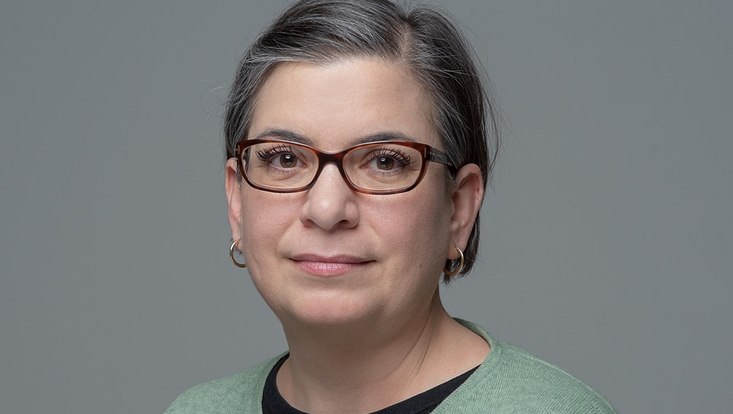Welcome aboard!“Learning a Dead Language Opens New Worlds”Prof. Dr. Nicole strengthens the humanities.
22 August 2023, by Brisch/Red.

Photo: Inger Ulrich
Every year, Universität Hamburg welcomes numerous new researchers. This series introduces them and their areas of research. This time: Assyriologist and philologist Prof. Dr. Nicole Brisch.
Prof. Dr. Nicole Brisch came to Universität Hamburg from the University of Copenhagen in Summer Semester 2023 to commence her appointment as Professor of Assyriology in the Faculty of Humanities.
My research area in 3 sentences:
My field is Assyriology, dealing with artifacts of handwritten cuneiform culture from ancient Mesopotamia (3300 BCE to 100 CE). In recent years, I have begun concentrating more on the religious history of the ancient Middle East, as these extensive sources provide us with a unique opportunity to observe the long-term perspectives on human religiosity. The last book I wrote, published together with my colleague Fumi Karahashi from the Chuo University in Japan, illuminated the role of women in the religious history of the ancient Middle East and Asia, thus contributing historical and non-western perspectives to women’s studies.
This is how I explain my research to my family:
Assyriology deals with pre-Christian Middle Eastern and west-Asian region, in the areas currently located in the states of Syria and Iraq. The area is often referred to as the cradle of civilization, also because writing was invented here approximately 3300 BCE, resulting in a unique, extraordinarily rich, and diverse textual legacy.
The writing system is known as cuneiform because it means “wedge-shaped”, after the wedge-shaped reed tool used to press small marks into soft clay tablets. The text sources may deal with banal matters like invoices or receipts, but also poetic and religious texts such as the Epic of Gilgamesch, one of the oldest epic poems in the world’s history. Cuneiform remained in use for more than 3000 years. The languages and cultures of ancient Mesopotamia allow us fascinating insights into early human history and thought.
In Hamburg, the city and the University, I am looking forward to:
I originally came from Berlin, but, with a few exceptions, I have lived abroad since 1998—firstly in the USA, then in the UK, and most recently, in Denmark. My impression is that both the city and Universität Hamburg are very dynamic, and my experience tells me that this dynamism and the high level of internationalization often produce new perspectives and synergies. I find it fascinating.
I am therefore really looking forward to working with my colleagues in the Asien-Afrika-Institut in the Faculty of Humanities as well as the Excellence Understanding Written Artefacts.
These are my plans at Universität Hamburg; this is what I would like to establish or strengthen:
Assyriology is being established as a degree program in the Asien-Afrika-Institut at Universität Hamburg. This is a huge challenge, but it offers us many opportunities to create an exciting new degree program.
In addition, I am particularly looking forward to contributing to the interdisciplinary research being conducted at the Center for Manuscript Cultures. I also find the profile initiative Thought and Religions in the Faculty of Humanities very interesting, and I can easily imagine working on a project on the role of priestesses, and how that has changed over the 2000 years of Christianity.
This is why students should come to my lectures:
Anyone interested in history and cultural history should absolutely come to my lectures! If we in Western societies want to conduct a dialog with non-Western societies, we also have to look at their cultural history, particularly as this constituted one of the earliest human achievements.
For this we have to look, among other things, at the Gilgamesh epic I mentioned. It is one of the oldest epic tales from a non-Western context, and is now taught in schools in the U.S. as part of non-Western world literature. We also look closely at the works of one of the first authors in world history ever, the priestess Enheduanna!
I also offer a language course in Akkadian, the oldest semitic language, and Sumerian as well as history courses. History is always based on religion, literature, economics, and society. Learning a dead language is always a challenge, but opens up new worlds.
Reaching out to the world: I work with the following international and federal institutions and universities:
As a small subject, Assyriology must have a strong international network to survive. I work with two of the most important digital initiatives in Assyriology, in cooperation with Oxford, Berlin, Munich, Philadelphia, and Berkeley. The archive I am working with is located in Chicago, Yale, and Baghdad. I have been working with colleagues in France for a few years on a book about textile coloration in ancient Mesopotamia, and have recently begun collaborating with Iranian colleagues conducting archaeological explorations in western Iran.
My research is important for society because:
In my opinion, it is enormously important to have freedom in research, even when its potential application is not immediately clear. In some cases, the importance of research results is only revealed after years or even decades of work.
That said, we should always be looking for relevant applications for our research, as my colleague Fumi Karahashi and I did for example with our book about women in religious history. In doing so, we showed that gender research plays an important role for a small discipline like Assyriology. We find this is particularly important in times such as now, when philosophers like Judith Butler attribute a “backlash” in society to gender studies.
Often, the past, even the very distant past, is used to support contemporary viewpoints, such as ancient Mesopotamian temple prostitution and the goddess Ishtar, which some have used as an argument against discriminatory attitudes to modern sex-work. But if you look more closely at the sources, you will find that there are other potential, and indeed more probable interpretations of the role of priestesses.


